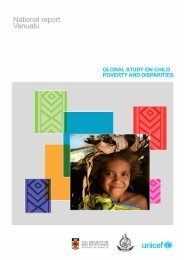STRATEGIC ASSESSMENT OF THE CHILDREN’S SERVICES INDUSTRY(OECD 2006, 6). Starting Strong II tries to capture children’s wellbeing in <strong>the</strong> present, aswell as <strong>the</strong>ir development as future citizens.Drawing upon <strong>the</strong>se principles, <strong>the</strong> OECD identified several issues that hamper Australia’sability to provide high quality services:• The lack <strong>of</strong> a clear vision regarding policy direction. The OECD suggested that astrategy framework be elaborated, drawing upon <strong>the</strong> ‘views and interests’ <strong>of</strong> children,families, communities, pr<strong>of</strong>essionals and researchers.• The need for system coherence and co-ordination, particularly given ‘<strong>the</strong>complexities <strong>of</strong> government in a federation <strong>of</strong> states, and <strong>the</strong> multi-layering <strong>of</strong>administration and regulation’.• The low status, poor pay and working conditions <strong>of</strong> staff, especially in settingslabelled ‘child care’. These, according to <strong>the</strong> OECD, have <strong>the</strong> potential to‘counterbalance’ government investment in <strong>the</strong> sector (2006, 272).2.2 Historical legaciesThe absence <strong>of</strong> a national approach to early education and care in Australia reflects deeplyentrenched historical legacies. ‘Child care’ for <strong>the</strong> children <strong>of</strong> working parents was, for manydecades, widely regarded as a service targeted at parents, providing a solution to <strong>the</strong> problem<strong>of</strong> safe custodial care for <strong>the</strong>ir children during work hours. By contrast, services deemed‘educational’ (such as preschool and kindergartens) were seen as child-focused. The hard andfast division between care and education is beginning to break down. It is widelyacknowledged that high quality child care provides far more than a custodial service and thatpreschool <strong>of</strong>fers respite to parents, as well as benefits to children. But <strong>the</strong> division between‘education’ and ‘care’ remains entrenched in discrete service types, funding formulae,regulations, <strong>the</strong> wages and industrial conditions <strong>of</strong> staff, <strong>the</strong> range <strong>of</strong> government departmentsthat have responsibility for <strong>the</strong> development <strong>of</strong> policy, <strong>the</strong> administration <strong>of</strong> funds and <strong>the</strong>regulation <strong>of</strong> services and even <strong>the</strong> physical fabric <strong>of</strong> some services.2.3 Changing patterns <strong>of</strong> family life and employmentAustralian families are changing rapidly. Many aspects <strong>of</strong> family life are markedly different at<strong>the</strong> beginning <strong>of</strong> <strong>the</strong> 21 st century to <strong>the</strong> way <strong>the</strong>y were only a decade or two ago. Today fewerpeople marry and more people remain unmarried or live in de facto relationships (Figure 2.1).Couple families with children are less common, with increasingly more single parent andchildless households (Figure 2.2). Today, just 40 per cent <strong>of</strong> families consist <strong>of</strong> two parentsliving only with <strong>the</strong>ir biological children (2020 Summit, 2008). More couples divorce andmore families consist <strong>of</strong> step-parents and children.3
STRATEGIC ASSESSMENT OF THE CHILDREN’S SERVICES INDUSTRYFigure 2.1: Marital status% people by marital status – Australia: 1996-2006100Figure 2.2: Australian households% households by family type – Australia: 1996-2006100 1.8% 1.8% 1.7%13.9% 15.4% 15.8%8039.9% 40.7% 40.8%80606.0%7.3% 8.8%6034.1%35.7% 37.2%40402054.1%51.9%50.4%2050.2%47.0%45.3%01996UnmarriedDe factoMarried200120060199620012006O<strong>the</strong>r householdSingle parent familyCouple family with no childrenCouple family with children 1Source: 2020 Summit, 2008Source: 2020 Summit, 2008Figure 2.3: Highest level <strong>of</strong>qualification: Australia, 1996-2006Figure 2.4: Crude birth rate and medianage <strong>of</strong> mo<strong>the</strong>rs at birth: 1976-2006% Population over 1560WomenMenMedian age at birth(yrs)35Fertility rate(births per woman)3.5503030.8yrs3.04040%2525.8yrs2.530110%20152.11.82.01.520101.01050.501986 1996 2006Bachelor degree or higherDiploma/CertificateSource: 2020 Summit, 20081986 1996 200601976 1981 1986 1991 1996 2001 2006Median age <strong>of</strong> mo<strong>the</strong>rs at birth (left hand axis)Fertility rate (right hand axis)Source: 2020 Summit, 20080.0Family formation is changing too. The rate at which women are attaining tertiaryqualifications is rising faster than it is for men; and women are having fewer children later inlife (Figures 2.3 and 2.4).4
















